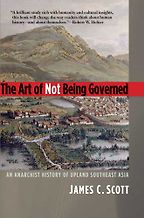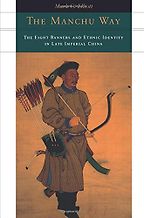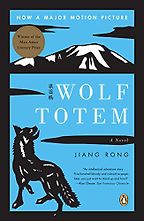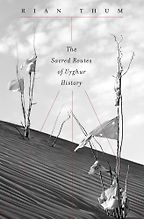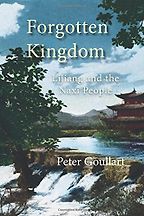Why are you interested in China’s ethnic minorities?
You can’t talk about China, today or in the past, without talking about ethnic identities. Apart from the issues around Chinese identity itself, the fates of Chinese empires, Han and otherwise, were so often decided in the borderlands. It also gives us a really powerful set of comparisons for thinking about identity, colonialism, and imperialism elsewhere.
Let’s start by talking about the most recent book you’ve chosen, James Scott’s The Art of Not Being Governed.
I love Scott, he’s one of my favourite authors. His fascination is with the way that states see populations and how people avoid being drawn into the eye of the state. This book focuses on ‘Zomia’—an area in southeast Asia crossing China, Vietnam, Laos, and other countries—where people were able to exist outside the reach of sovereign states. His argument is that what we now think of as the ‘tribal people’ or ‘minorities’—like the Hmong—were originally people who went up into the hills to avoid the reach of settled empires. These peoples, he argues, used all kinds of strategies to avoid becoming part of empires.
His most controversial point—which he rather wonderfully says he’s not sure he even believes himself— is that some of these groups might even have deliberately given up literacy or not adopted literacy. If you have a written record of your past, you’re bound to it: ‘This is who we were before, these are the agreements we made.’ But if you rely on an oral tradition, you can have the kind of changing faith where you can say, ‘We’re actually Chinese, we’re actually Thai, we’re actually our own people…’
The Chinese empire has always had a very ambiguous relationship with the region. If you look at Chinese records, you’ll find this powerful antipathy for the southwest, even when it’s formally part of China. They describe Yunnan as malarial, hard to get to, hard to impose your will on. There’s constant rebellion, constant bucking against the power of the state, and the mandarins really dislike it.
Does this apply down to the present day?
For the state, ethnic minorities in China now are all about categorization. After the People’s Republic of China was founded, there were 56 ethnic groups, including the Han, who are the majority. Everybody has one or the other listed on their identity card. It’s all about saying ‘You are this, you are that,’ whereas in the past it had been about flexibility, about splintering into smaller groups or smaller groups coming together. So, with modernity, the reach of the state has expanded. Villages are more connected, technology allows you to categorize or track people more easily. These flexible identities have disappeared for a lot of people, they’ve become fixed. Traditionally there’s been a lot of people crossing borders. For instance, people who lived on the China-Myanmar border would go over to the Myanmar side because the reach of the state there was weaker. There is still a lot of flexibility around those borders, there are a lot of people who have positioned themselves between states.
Another argument Scott puts forward is about the interdependence between the state and those who have retreated into the hills. What role does the state want the minority to play?
The Chinese state wants them to be this quaint, backward people you can go see but who don’t have any actual agency of their own. They want them to be a tourist attraction where you see people doing their funny dances in their funny costumes. In Beijing you literally have an ‘Ethnic Minority Park,’ which used to have a sign outside in Chinglish saying, quite accurately, ‘Racist Park.’ Their experiences are reduced to the level of Disney’s ‘It’s a Small World After All.’ They’ve become exhibitions — a bit like Indian shows in the US in the early 20th century.
Yet you also get practices that were once mainstream Chinese culture, that were destroyed by the PRC and Maoism, but have survived in southeast Asia and among the minority groups. These are traditions that were once mainstream Han practices but are now identified as ‘minority’ practices. For instance, Anne Fadiman’s book, The Spirit Catches You And You Fall Down, which is about the Hmong in California, centers around the semi-shamanic tradition calling for the soul to come back to the body. This is very much portrayed as a Hmong tradition, which it is. But it was once standard Han Chinese practice, the jiao hun or soul-calling that you can find described in pre-20th century texts. It was wiped out under Communism because it was superstition. But it survived in little ethnic minority pockets. A European example would be the bagpipes. This was once a standard musical instrument across Europe, but it died out everywhere else and survived up in Scotland, in the hills.
Get the weekly Five Books newsletter
Let’s turn now to one of the more successful Chinese ethnic minorities, the Manchus, and Mark Elliott’s book, The Manchu Way.
Normally, the minorities are the subjects. The Manchus, however, were in charge. They took over China in 1644, overthrew the Han Chinese Ming, and became the Qing, one of the most successful Chinese dynasties. Qing borders, with the exception of outer Mongolia, pretty much define the shape of China today. So for a long time, in modern Chinese historiography, Chinese historians treated the Qing as if they had been rapidly Sinified. They said that they lost their Manchu identity and became just another dynasty.
In the 1980s and 90s, you started to get a pushback against that, mostly from American historians who had gone back to the Manchu sources and learned Manchu and said, ‘No, the Qing always kept a strong Manchu identity.’ They saw China as just one part of the bigger Manchu empire that they controlled, and the Chinese identity as only one identity they subsumed.
The book is fascinating because it was one of the earliest books in the ‘New Qing History’ tradition. It shows that, faced with the threat of losing their Manchu identity, the Qing tried all these measures to keep themselves Manchu and force people to stick to the old ways. He argues that these methods didn’t quite work but instead Manchus developed their own ways of being Manchu that weren’t necessarily what the authorities wanted, but were based on their own sense of self. You have the government both trying to impose a vision of what being a minority is—in this case the ruling minority—and at the same time people facing all these daily pressures to be more like the Han and settle down. There’s always this mix pressing on peoples’ sense of self.
What value did they see in keeping their own Manchu identity?
Firstly, people are proud of their own history and don’t want to be swallowed up. The Manchu were very conscious that some earlier dynasties had lost their identity as northern, hunting peoples. The Jin, an earlier, Manchu-related dynasty, had given up hunting among the royal family 50 years after they conquered north China. The hunt was a big part of their identity: it kept you tough, it showed that you were still connected to your origins. In the Confucian tradition, hunting was slightly vulgar and not something the Emperor should be doing. They didn’t want it to happen to them.
They were also conscious that they were controlling a big range of peoples. The Han Chinese, the central kingdoms, were the core of their power but their control reached way up north and west. They were controlling peoples for whom they had an appeal as still being authentically northern. Their control over Mongolia, for instance, was very much rooted in having a Mongol identity as rightful heirs to Genghis Khan.
There is also a proto-environmentalism there. They really have a sense that the northern lands are threatened by the Chinese way of life, by Han settlement, so they spend a lot of time trying to keep their original homes in the north protected from settlement. They had a strong understanding of the fragility of these grassland areas and how they could be destroyed by mass settlement, so they tried to pin the Han behind the Great Wall. It doesn’t really succeed though. They wonderfully describe the Han Chinese who settled illegally as ‘weed people,’ overrunning this beautiful green area.
Were there downsides to playing up this Manchu identity?
Chinese revolutionaries always defined themselves as anti-Manchu. The big symbol of that was that the Manchu imposed their own haircut on almost all of China. The queue, with the forehead shaved and the hair high on the back of the head was a distinctly northern style, adopted so that hair won’t fall in your eyes while riding a horse. The first act of revolutionaries was always to cut off the queue. You see this anti-Manchu nationalism up until 1911 when the Manchu fall.
The funny thing is the Manchu identity of the Qing is then defined out of history by the PRC. They realize that all of their boundaries and claims—particularly in Inner Mongolia, Manchuria and Xinjiang—are all based on Qing dynasty conquests. They can’t say that these people weren’t Chinese, because if they say that they have to say that all the places the Qing won aren’t Chinese either. So, instead, they define the Manchus as having really been Chinese all along, which is why books like Elliott’s have gotten huge pushback among official Chinese historians and in state media.
Let’s go on to a recent bestseller, Wolf Totem by Jiang Rong.
This was a huge hit. I don’t think it’s a very good book, but it’s interesting. It’s about the relationship between Han Chinese and Mongols. It positions the Mongols as this kind of in-touch-with-nature, fierce, warrior people, like wolves, and the Han as these settled ‘sheeple.’ He’s very admiring of the Mongols but doesn’t let them speak for themselves. They’re only defined in opposition to what being Chinese is. It’s like in 20th century America, where you get books praising the Indians for being brave and noble and primitive, and having these wonderful values that American society has lost. There’s no space for the Mongols to be anything other than a monument to the past. It reduces them to a stick to hit the Chinese with for being too passive and bowing to authority.
“The wild, barbarous, noble, primitive image is an appealing one. It touches some core, call-of-the-wild impulse we have.”
Why do you think the book struck such a chord?
That sort of romanticism is always popular. Look at The Last of the Mohicans, or way back to those Roman statues like The Dying Gaul. The wild, barbarous, noble, primitive image is an appealing one. It touches some core, call-of-the-wild impulse we have. A lot of Chinese are profoundly ambivalent of their own society. They look around and see people who are too meek.
It also taps into this victim narrative in Chinese culture. It portrays the Chinese as being, historically, weak, passive victims of more powerful people. It ties into the belief that China has always been this peaceful country that other countries, because they’re too passive, have been able to prey upon. This isn’t true historically: the Chinese were an aggressive, expansionist power who tried to impose their authority all over the place. But it plays into this modern interpretation of what history was, how China suffered under the Western powers, and so on. There’s this weird mixture of self-loathing and self-promotion.
How did ethnic Mongols react to this book?
Most Mongols despise Chinese — not being Chinese is one of the defining factors in Mongolian identity nowadays. I talked to one Mongol guy who had read it who said ‘Yeah, we are wolves and strong and the Chinese are weak and passive!’ Ironically, both sides like to play up this stereotype. The Mongol men love the idea that they’re this fierce, masculine, powerful people. Mongol women are a little more balanced.
Also, to portray Mongols as having this intimate relationship with wolves is funny. In most of Mongolia wolves are treated as pests and Mongols hunt them in the back of 4x4s with rifles. No mystical stuff there.
Let’s go on to a book about another ethnic group trying to maintain its identity, the Uighurs. Your fourth book is Rian Thum’s The Sacred Routes of Uyghur History.
They aren’t trying to maintain as much as reinvent their sense of identity. The modern Uighur, who are a collection of Turkic peoples, really almost picked that identity. They looked back at history and said, ‘We are the Uighur who had this powerful empire that the Chinese feared.’ They built this identity, as Thum documents, through shrines, through pilgrimage routes and by going back to the historical record of this empire the Chinese had to deal with as equals under the Tang dynasty.
The actual historical connection between the Uighurs and today’s people is pretty shaky. But they created this identity themselves from the ground up. I’m not dismissing the idea of the connection, but they chose it.
Which seems to connect pretty well to James Scott’s thesis.
Absolutely. For him, ethnic identities aren’t fixed. They’re strategies you adapt your reality towards and you play up and play down parts of them to cope with realities of the day. What Scott doesn’t really talk about that you have now is this keen oppositional identity. A lot of Uighur I know now, even in Beijing, won’t eat in Han restaurants and will associate with Chinese as little as possible. This is something that has changed. There has been lots of mixing historically, but because of the rigor of the rule in Xinjiang, where you have this really brutal crackdown, people’s identities are becoming stronger. Uighur meaning ‘not Chinese’ is getting more powerful by the year.
The strategy is counterproductive. It causes more Uighur identity to survive in the long run, but it feels like a dead end for the Uighur. They’ve been forced into it because there’s no space for having a more accepting Uighur identity. It’s starting to take on strains of Salafist Islam and jihadism. It worries me when people define themselves narrowly. It leaves people who are half Uighur with this really hard position. When it’s a choice between being the happy, singing minority or this fierce anti-Chinese people, standing up for their self-respect, they pick the second one. We’re mostly talking about young men here. They most fiercely need that identity. They need to believe in something, and for a lot of young Uighur that something is being Uighur and not being Chinese.
Our fifth and last book looks at the Naxi. Tell me about Peter Goullart’s Forgotten Kingdom.
Goullart was a White Russian exile who was raised in China. His mother fled Russia when he was four or five and he grew up speaking Chinese. He became a very passionate Taoist and also a big believer in ghosts and other supernatural beings. He went to work in Lijiang, a big Yunnanese city where all these minorities mixed. The Naxi were the main one, but lots of little groups came into town to trade, to gossip, to tell stories. He was working there for the Chinese Industrial Cooperatives, which were a form of microfinance run by the KMT. He arrived in the mid-1930s and was working mostly with women, the main partners in these schemes. He was giving them loans and helping them come together.
I wanted to finish on this book because I think it’s one of the most beautiful and productive images of minority life in China. Lijiang is this big trading, storytelling town where people are sitting down together, doing business, talking. He has this real sense of love for the place, for all these different peoples and for how dynamic it is. I imagine it must be a little exaggerated — he does mention fighting and banditry too. But there’s this image of people coming together to make something bigger than themselves and not defined by any one group. This is the absolute best of what ethnic identity in China is about.
How did it turn out for the Naxi after the PRC was established?
The Maoists destroyed all the things that mattered to Lijiang and the Naxi. The festivals, the shrines, the stories, the trading, all of that was anathema to Maoist ideology of what a nation should be. It was wiped out as much as they could. They really shattered this dynamic place. People nowadays, many of them on the Han side, are trying to reconstruct and reimagine it.
What do you think made the Lijiang model work when it did?
You have no one dominant group. The Naxi are the most powerful group but they’re not the only game in town. I think the role of trade was important. When you’re doing this kind of small-scale trade it’s hugely conducive to cultural exchange. Also, female dominance helped. Women ran the trade and the bars. The young men in their twenties, who are most susceptible to hard interpretations of identities, were sidelined. I think older women in particular tend to have smarter or more flexible senses of what these identities can be.
Five Books aims to keep its book recommendations and interviews up to date. If you are the interviewee and would like to update your choice of books (or even just what you say about them) please email us at [email protected]
Five Books interviews are expensive to produce. If you've enjoyed this interview, please support us by donating a small amount.
